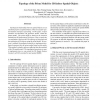797 search results - page 35 / 160 » Spatial Relations Analysis by Using Fuzzy Operators |
BPM
2009
Springer
14 years 3 months ago
2009
Springer
The goal of performance analysis of business processes is to gain insights into operational processes, for the purpose of optimizing them. To intuitively show which parts of the pr...
WSC
2004
13 years 10 months ago
2004
Traffic Flow Management (TFM) actions are commonly used to mitigate capacity/demand imbalances within the National Airspace System (NAS). Modeling TFM events has proven challengin...
AWIC
2003
Springer
14 years 2 months ago
2003
Springer
Abstract. In this paper we present a method based on fuzzy computing with words to measure the informative quality of Web sites used to publish information stored in XML documents....
MDM
2009
Springer
14 years 3 months ago
2009
Springer
Topological relationships between spatial objects are an essential property of spatial objects. They are used for spatial analysis and query processing. In this paper, we first i...
BMCBI
2004
13 years 8 months ago
2004
Background: Hidden Markov Models (HMMs) have proven very useful in computational biology for such applications as sequence pattern matching, gene-finding, and structure prediction...

